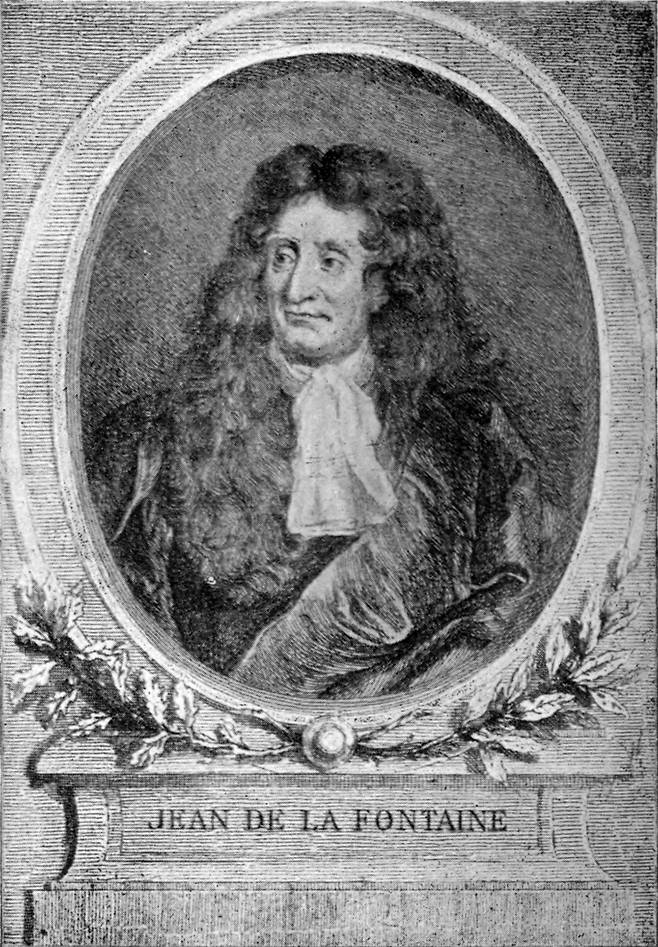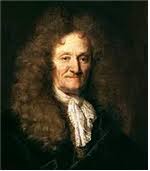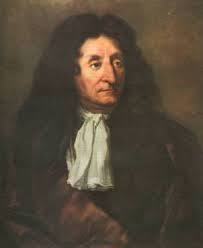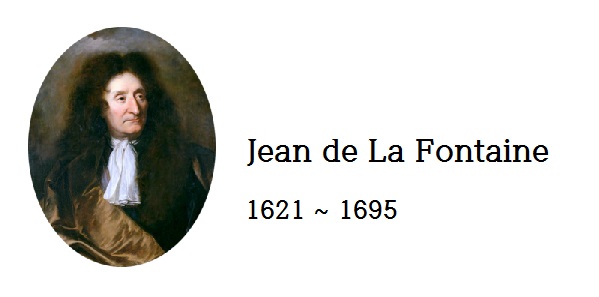1695년 4월 13일, 프랑스의 작가 장 드 라퐁텐 (Jean de La Fontaine, 1621 ~ 1695) 별세
장 드 라 퐁텐 (Jean de La Fontaine, 1621년 7월 8일 ~ 1695년 4월 13일)은 프랑스의 시인이자 동화 작가이다.

– 장 드 라 퐁텐 (Jean de La Fontaine)
.출생: 1621년 7월 8일, 샤토티에리
.사망 1695년 4월 13일, 파리
.국적: 프랑스
.언어: 프랑스어
.직업: fabulist, 시인, 변호사, 아동 문학가, French moralist, 작가, 극작가
.학력: College of Juilly
.부모: Charles de la fontaine(부), Françoise Pidoux(모)
.배우자: Marie Héricart
17세기 프랑스의 대표 우화 작가이자 시인이다. 어렸을 때부터 숲을 산책하고, 책을 읽고, 생각하는 것을 좋아했다.
글 솜씨가 아주 뛰어나 감동과 재미가 담긴 그을 많이 썼다.
라퐁텐이 살았던 때, 귀족과 왕족은 호화롭게 살았지만 백성은 가난하고 어렵게 살았다.
라퐁텐은 우화를 쓰며 이러한 세상을 비판하고, 권력층에 맞서 싸웠다.
라퐁텐의 우화는 문학적으로도 가치가 높아, 세계 사람들이 즐겨 읽는 이야기가 되었다.
작품으로는 <우화시>, <필레몽과 보시스>, <미네의 딸>, <라고탱>, <마법의 술잔>, <아스트레> 등이 있다.

○ 생애 및 활동
라 퐁텐은 1621년 7월 8일 프랑스 샹파뉴의 샤토티에리에서 태어났다.
그는 자연 속에서 성장하면서, 자연과 자유를 사랑하게 되었다.
후에는 고전을 연구하며 시·극·우화 등을 썼다.
판차탄트라와 같은 고대 인도 문학, 이솝, 호레이스 등에서 영감을 받아서 1668년에서 1695년까지 발표한 시문으로 된 우화집으로 유명하다.
라 퐁텐의 우화는 이솝 우화에 비해 내용 면에서 인간 세태에 대한 풍자의 강도가 세다.
루이 14세의 여섯 살 난 손자에게 헌정된 최초의 우화집인 《우화 선집》 (Fables Choisies)에는 124개의 우화가 실려 있는데, 동물에 비교하여 사람의 참다운 모습을 생각케 해 주는 뛰어난 작품이다. 프랑스 언어의 시적 기능을 잘 살린 수작으로 꼽힌다.
오늘날에도 프랑스 지식인들은 라 퐁텐의 시구절을 즐겨 인용한다.
1995년 프랑스에서는 라 퐁텐과 우화 기념우표 시리즈를 발간한 바 있다.
한국어로는 《라 퐁텐 우화집》 또는 《라 퐁텐 그림우화》와 같은 제목으로 번역된 적이 있다.
그의 소설로 《프시케와 큐피드의 사랑 이야기》 등이 있다.
라퐁텐은 1695년 4월 13일, 프랑스 파리에서 별세했다.

○ 저서
* Individual fables – The following fables have individual articles devoted to them:
The Acorn and the Pumpkin (Le gland et la citrouille, IX.4)
The Ant and the Grasshopper (La cigale et la fourmi, I.1)
The Ass and his Masters (L’âne et ses maitres, VI.11)
The Ass Carrying Relics (L’âne portant des reliques, V.14)
The Ass in the Lion’s Skin (L’âne vêtu de la peau du lion, V.21)
The Astrologer who Fell into a Well (L’astrologue qui se laisse tomber dans un puits, II.13)
The Bear and the Gardener (L’ours et l’amateur des jardins, VIII.10)
The Bear and the Travelers (L’ours et les deux compagnons, V.20)
The Belly and the Members (Les membres et l’estomac, III.2)
The Bird Wounded by an Arrow (L’oiseau blessé d’une flèche, II.6)
The Cat and an Old Rat (Le chat et un vieux rat, III.18)
The Cat Turned into a Woman (La chatte métamorphosée en femme, II.18)
The Coach and the Fly (Le coche et la mouche, VII.9)
The Cobbler and the Financier (Le savetier et le financier, VIII.2)
The cock and the fox (Le coq et le renard, II.15)
The cock and the pearl (Le coq et la perle, I.20)
Death and the woodman (La Mort et le bûcheron, I.16)
The Dog and Its Reflection (Le chien qui lâche sa proie pour l’ombre, VI.17)
The Dog and the Wolf (Le loup et le chien, I.5)
The dog who carries his master’s dinner round his neck (Le chien qui porte à son cou le dîner de son maître, VIII.7)
The Dove and the Ant (La colombe et la fourmi, II.12)
The drowned woman and her husband (La femme noyée, III.16)
The Eagle and the Beetle (L’Escarbot et l’aigle, II.8
The earthen pot and the iron pot (Le pot de terre et le pot de fer, V.2)
The Farmer and his Sons, (Le laboureur et ses enfants, V.9)
The Farmer and the Viper (Le villageois et le serpent, VI.13)
The fish and the flute-playing shepherd (Les poissons et le berger qui joue de la flûte, X.11)
The fisherman and the little fish (Le petit poisson et le pêcheur, V.3)
The Fly and the Ant (La mouche et la fourmi, IV.3)
The Forest and the Woodcutter (La forêt et le bûcheron, X11.16)
The fox and the bust (Le renard et le buste, IV.14)
The fox and the crow (Le corbeau et le renard, I.2)
The Fox and the Grapes (Le renard et les raisins, III.11)
The Fox and the Sick Lion (Le lion malade et le renard, VI.14)
The Fox, the Flies and the Hedgehog, (Le renard, les mouche et le hérisson, XII.13)
The Frog and the Mouse (La grenouille et le rat, IV.11)
The Fox and the Stork (Le renard et la cigogne, I.18)
The Frog and the Ox (La grenouille qui veut se faire aussi grosse que le boeuf, I.3)
The Frogs Who Desired a King (Les grenouilles qui demandent un roi, III.4)
The Girl (La Fille, VII.5), see under The Heron and the Fish
The Goose that Laid the Golden Eggs (La Poule aux oeufs d’or, V.13)
The heifer, the goat and the sheep in company with the lion (La génisse, la chèvre et le brebis en société avec le lion, I.6)
The Heron, (Le Héron, VII.4)
The Horse and the Donkey (Le cheval et l’âne, VI.16)
The Horse that Wanted to get Its Own Back (Le cheval s’étant voulu venger du cerf, IV.13)
The Jay Dressed in Peacock Feathers (Le geai paré des plumes du paon, IV.9)
The Kite and the Nightingale (Le milan et le rossignol, IX.17)
The Lion and the Mouse (Le lion et le rat, II.11)
The Lion Grown Old, (Le lion devenu vieux, III.14)
The Lion in Love (Le lion amoureux, IV.1)
The lion subdued by the man (Le lion abattu par l’homme, III.10)
The man and the wooden idol (L’homme et l’idole de bois, IV.8
The Man who Runs after Fortune (L’homme qui court après la fortune et l’homme qui l’attend dans son lit, VII.12)

The Man with two Mistresses (L’homme entre deux âges et ses deux maîtresses, I.17)
The Mice in Council (Conseil tenu par les rats, II.2)
The Milkmaid and Her Pail (La laitière et le pot au lait, VII.10)
The Miller, His Son, and the Donkey (Le meunier, son fils, et l’âne, III.1)
The Miser Who Lost his Treasure (L’avare qui a perdu son trésor, IV.20)
The Monkey and the Cat (Le singe et le chat, IX.17)
The Mountain in Labour (La montagne qui accouche, V.10)
The Mouse and the Oyster (Le rat et l’huître, VIII.9)
The Mouse Turned into a Maid (La souris métamorphosée en fille, IX.7)
The Oak and the Reed (Le chêne et le roseau, I.22)
The Old Cat and the Young Mouse (Le vieux chat et la jeune souris, XII.5)
The Old Man and his Sons (Le vieillard et ses fils, IV.18)
The Old Man and the Ass (Le vieillard et l’âne, VI.8
Phoebus and Boreas (Phébus et Borée, VI.3)
The thieves and the ass (Les voleurs et l’âne, I.13)
The torrent and the river (Le torrent et la rivière, VIII.23)
The sun and the frogs (Le soleil et les grenouilles, VI.12, XII.24)
The swan and the cook (Le cygne et le cuisinier, III.12)
The Tortoise and the Birds (La tortue et les deux canards, X.3)
The Tortoise and the Hare (Le lièvre et la tortue, VI.10)
The Town Mouse and the Country Mouse (Le rat de ville et le rat des champs, I.9)
The treasure and the two men (Le trésor et les deux hommes, IX.15)
The Two Pigeons (Les deux pigeons, IX.2)
The Vultures and the Pigeons (Les vautours et les pigeons, VII.8
The weasel in a granary (La belette entrée dans un grenier, III.17)
The Wagoner Mired (Le charretier embourbé, VI.18)
The Wolf and the Crane (Le loup et la cigogne, III.9)
The Wolf and the Lamb (Le loup et l’agneau, I.10)
The Wolf and the Shepherds (Le loup et les bergers, X.5)
The Wolf who Played Shepherd (Le loup devenu berger, III.3)
The Women and the Secret (Les femmes et le secret, VIII.6)
The Woodcutter and Mercury (Le bûcheron et Mercure, V.1)
The Young Widow (La jeune veuve, VI.21)

참고 = 위키백과, 교보문고
크리스천라이프 편집부

